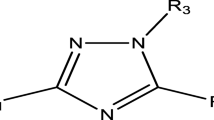Abstract
Time consumed and expenses in discovering and synthesizing new hypothetical drugs with improved biological activity have been a major challenge toward the treatment of multi-drug resistance strain Mycobacterium tuberculosis (TB). To solve the above problem, Quantitative structure activity relationship (QSAR) is a recent approach developed to discover a novel drug with a better biological against M. Tuberculosis. A validated QSAR model developed in this study to predict the biological activities of some anti-tubercular compounds and to design new hypothetical drugs is influenced with the molecular descriptors; MATS2s, nHBint3, maxtsC, TDB9u, RDF90i and RDF110s. Molecular docking studies was as well carried for all the studied compounds in order to show the interactions and binding modes between the ligand and the receptor (DNA gyrase). The lead compound (compound 41) with higher anti-tubercular activity was observed with prominent binding affinity of − 21.9 kcal/mol compared to the recommended drugs; Isoniazid (− 14.6 kcal/mol). Therefore, compound 41 served as a template structure to designed compounds with more efficient activities. Among the compounds designed; compounds 41p was observed with better anti-tubercular activities with more prominent binding affinities of − 24.3 kcal/mol. The findings in the research will be valued to pharmacology, medicinal chemists and pharmacist to design and synthesis a novel drug candidate against the tuberculosis. Moreover, in vitro and in vivo test could be carried out to validate the computational results.











Similar content being viewed by others
References
W.H. Organization, Others (2016) Tuberculosis Fact Sheet (No. 104) 2000, Site Accessed Www Who Intmediacentrefactsheetswho104enindex Html
Adeniji SE, Uba S, Uzairu A (2020) Theoretical modeling for predicting the activities of some active compounds as potent inhibitors against Mycobacterium tuberculosis using GFA-MLR approach. J King Saud Univ Sci 32:575–586
Ogadimma AI, Adamu U (2016) Analysis of selected chalcone derivatives as Mycobacterium tuberculosis inhibitors. Open Access Libr J 3:1–13
Adeniji SE, Uba S, Uzairu A (2018) QSAR Modeling and Molecular Docking Analysis of Some Active Compounds against Mycobacterium tuberculosis Receptor (Mtb CYP121). J Pathog. Article ID 1018694
Adeniji SE, Uba S, Uzairu A (2018) A novel QSAR model for the evaluation and prediction of (E)-N’-benzylideneisonicotinohydrazide derivatives as the potent anti-mycobacterium tuberculosis antibodies using genetic function approach. Phys Chem Res 6:479–492
Eric GM, Uzairu A, Mamza PAA (2016) Quantitative structureactivity relationship (QSAR) study of the anti-tuberculosis activity of some quinolones. J Sci Res Rep 10:1–15
Singh P (2013) Quantitative structure-activity relationship study of substituted-[1,2,4] oxadiazoles as S1P1 agonists. J Curr Chem Pharm Sci 3:64–79
Arthur DE, Uzairu A, Mamza P et al (2018) In silico modelling of quantitative structure–activity relationship of multi-target anticancer compounds on k-562 cell line. Netw Model Anal Health Inform Bioinforma 7:11
Adeniji SE, Uba S, Uzairu A, ArthurDE (2019) A derived QSAR model for predicting some compounds as potent antagonist against mycobacterium tuberculosis: a theoretical approach. Adv Prev Med Article ID 5173786
Tropsha A, Gramatica P, Gombar VK (2003) The importance of being earnest: validation is the absolute essential for successful application and interpretation of QSPR models. Mol Inform 22:69–77
Roy K, Chakraborty P, Mitra I, Ojha PK, Kar S, Das RN (2013) Some case studies on application of “rm2” metrics for judging quality of quantitative structure–activity relationship predictions: emphasis on scaling of response data. J Comput Chem 34:1071–1082
Veerasamy R, Rajak H, Jain A, Sivadasan S, Varghese CP, Agrawal RK (2011) Validation of QSAR models-strategies and importance. Int J Drug Des Discov 3:511–519
Piton J, Petrella S, Delarue M, Andre´-Leroux G, Jarlier V, Aubry A, Mayer C (2010) Structural insights into the quinolone resistance mechanism of mycobacterium tuberculosis DNA gyrase. PLoS One 5:12245. https://doi.org/10.1371/journal.pone.0012245
Adeniji SE, Uba S, Uzairu A (2018) Theoretical modeling and molecular docking simulation for investigating and evaluating some active compounds as potent anti-tubercular agents against MTB CYP121 receptor. Future J Pharm Sci 4:284–295
Ibrahim MT, Uzairu A, Shallangwa GA, Uba S (2020) In-silico activity prediction and docking studies of some 2, 9-disubstituted 8-phenylthio/phenylsulfinyl-9 h-purine derivatives as Anti-proliferative agents. Heliyon 6:e03158
Abdullahi M, Shallangwa GA, Uzairu A (2020) In silico QSAR and molecular docking simulation of some novel aryl sulfonamide derivatives as inhibitors of H5N1 influenza A virus subtype. Beni-Suef University. J Basic ApplSci 9:1–13
Patil R, Das S, Ashley S, Yadav L, Sudhakar A, Ashok KV (2010) Optimized hydrophobic interactions and hydrogen bonding at the target-ligand interface leads the pathways of drug-designing. PLoS One 8:1–10
Author information
Authors and Affiliations
Corresponding author
Ethics declarations
Conflict of interest
On behalf of all authors, the corresponding author states that there is no conflict of interest.
Rights and permissions
About this article
Cite this article
Adeniji, S.E., Arthur, D.E., Abdullahi, M. et al. Quantitative Structure–Activity Relationship Model, Molecular Docking Simulation and Computational Design of Some Novel Compounds Against DNA Gyrase Receptor. Chemistry Africa 3, 391–408 (2020). https://doi.org/10.1007/s42250-020-00132-9
Received:
Accepted:
Published:
Issue Date:
DOI: https://doi.org/10.1007/s42250-020-00132-9




